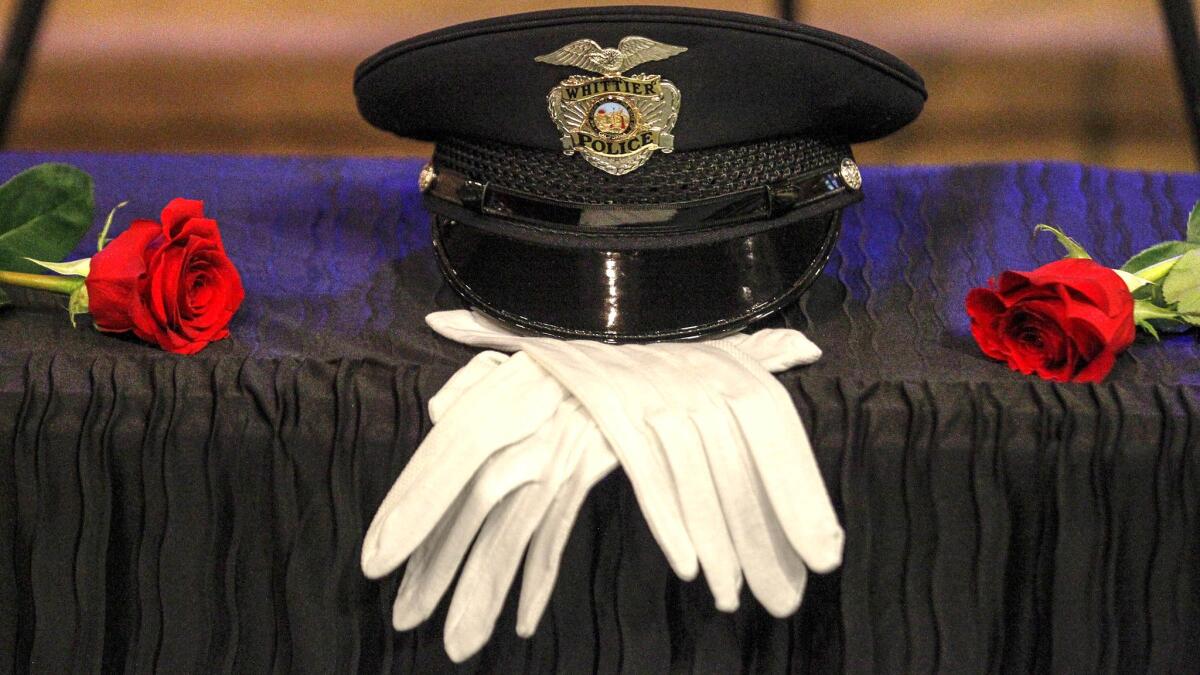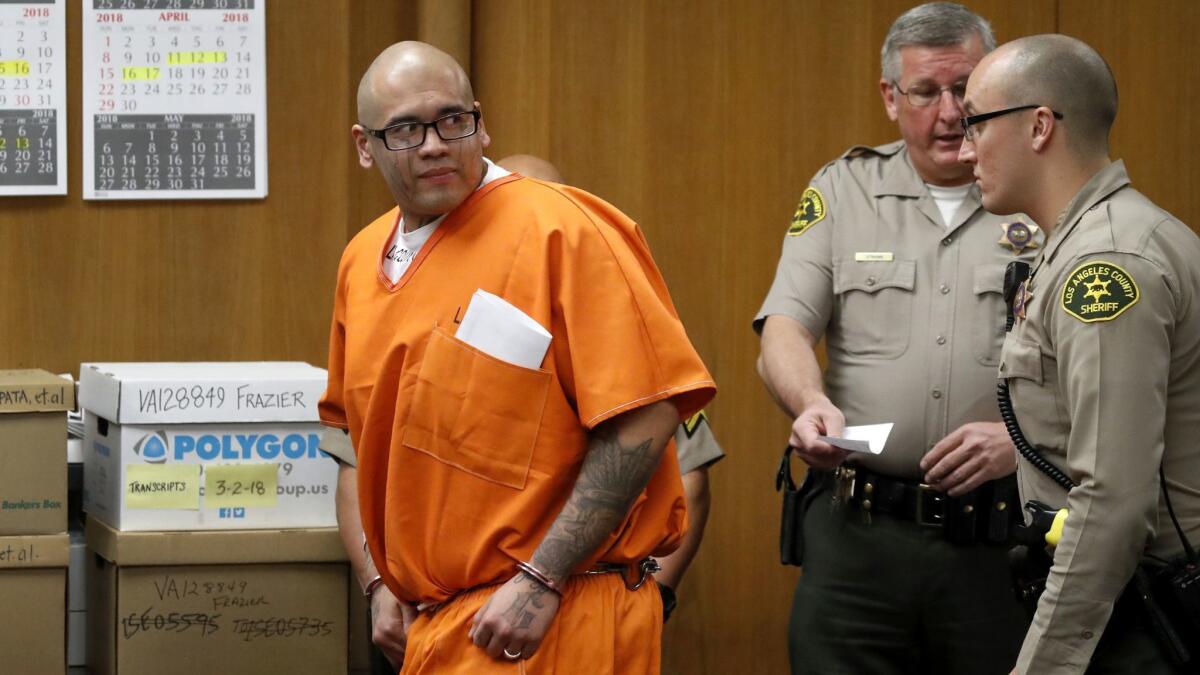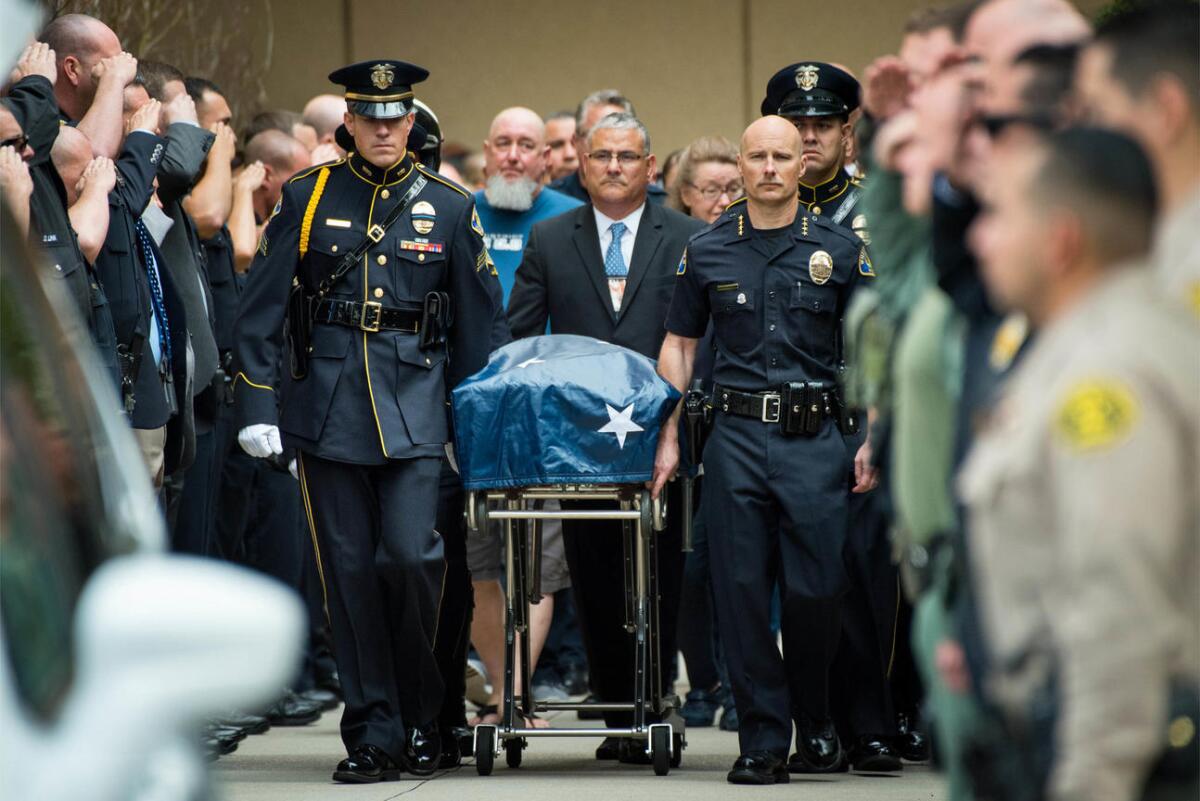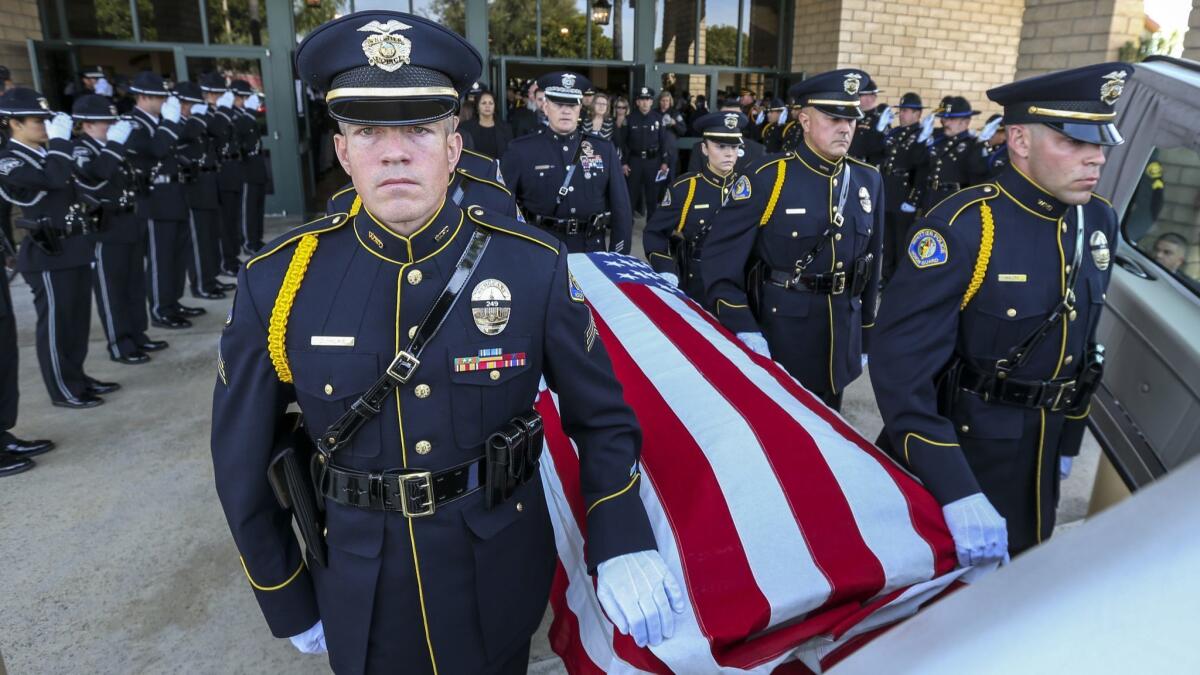A gang member killed a cop nine days after he got out of jail. Did California’s justice reforms play a role?

In the heated debate over California’s efforts to slash its prison population, the case of Michael Christopher Mejia has become a political rallying cry.
An admitted gang member, Mejia was charged last year with shooting two Whittier police officers — a crime the city’s mayor and many in law enforcement saw as clear evidence of the failure of less strict sentencing laws.
Why, they asked, was Mejia even on the streets?
The killing of Officer Keith Boyer and wounding of another officer have galvanized a movement to ask state voters this November to reverse some of the recent changes to sentencing laws and the prison system.
But a review of the case by The Times and the Marshall Project found a far more complex chain of events that allowed Mejia to remain free despite his record of criminal behavior.
Confidential findings by criminal justice experts appointed by Los Angeles County to examine Mejia’s case identified local law-enforcement failures that had little to do with the state’s justice reforms.
The group concluded that Mejia was allowed to cycle in and out of jail with little punishment or treatment for his escalating drug problems because county agencies failed to document all of his rule-breaking, didn’t share important information with one another and gave him an excessive number of chances while he continued breaking the rules of his supervision, according to confidential county reports.
At the same time, court records reviewed by The Times and the Marshall Project show, the district attorney’s office missed an opportunity to send Mejia to jail and drug treatment for several months in the weeks before the shootings.

The documents provide important new details about a case that has played a key role in the political debate over whether California’s criminal justice reforms have gone too far.
The state has become a national leader in easing tough sentencing laws imposed during the 1990s. Many in local law enforcement argue that prison releases and sentencing changes have caused crime to jump in some areas, though backers of the reform movement dispute those claims.
One of the experts on the county panel that reviewed Mejia’s case said the group’s findings did not discredit California’s recent changes in its prison system or sentencing laws.
“If the premise is, this is the golden case to show failures, I just don’t think you can point to this case and say it shows the failures,” said Cynthia Hernandez, a lawyer who has served as an independent monitor of the county’s probation department. “Of course we’d want a different outcome — it’s a tragedy. But I’d be hard-pressed to find the link.”
Another member of the panel, Arcadia Police Chief Bob Guthrie, said he saw the state’s massive prison downsizing laws as an important backdrop to Mejia’s case.
“I’ve never stated there is a direct connection, nor would I now,” said Guthrie, who declined to comment on the report’s findings. “Do I believe there’s a correlation? Yes, I do. Whatever Mejia would have done absent [prison downsizing], we’ll never know.”
Guthrie, the president of the Los Angeles County Police Chiefs Assn., said some of the changes have made it more difficult for authorities to put away hardened offenders who violate the terms of their supervision or are caught committing lower-level crimes. A 2014 initiative that reduced many drug offenses to misdemeanors, he said, took away an important tool to force people into drug treatment that would be monitored by the courts.
Report kept secret
Other members of the 22-person panel declined to comment, saying the county had required them to sign a nondisclosure agreement about their work. County lawyers have rejected several requests to make the group’s findings public.
The shooting of the Whittier police officers occurred hours after Mejia killed his cousin, authorities say. The next day, the Board of Supervisors directed county agencies to examine probation officials’ supervision of Mejia after his release from prison the previous year. The committee included representatives from the county probation department, district attorney’s office and Sheriff’s Department, as well as outside experts.

Among its findings:
- Mejia’s probation officer used an “excessive” number of short jail stints, aimed at stopping his bad behavior. Instead, Mejia’s supervision should have been revoked, sending him to jail for a longer time.
- Mejia, who had a history of drug abuse, should have been referred to substance-abuse treatment screening as soon as he was released from prison. But the county waited until he admitted using heroin and requested help. Even then, the county waited two weeks before getting him an initial drug treatment screening, which he didn’t show up to.
- When the probation department did finally decide to get tough, an officer recommended Mejia spend three months in jail followed by court-ordered residential drug treatment. But the prosecutor handling the case did not include the probation officer in plea negotiations and so was unaware of the extent of Mejia’s escalating drug and gang activity. The prosecutor asked a judge to send Mejia to jail for only a month.
Timeline: An L.A. gang member’s months of rule breaking before a cop killing »
The panel suggested a number of fixes, including providing drug screening and treatment in jail; requiring drug-treatment staff to notify probation officers about missed appointments; and limiting the number of short jail stays for high-risk offenders before revoking probation. The committee also recommended that the state, rather than the county, be allowed to supervise some offenders who have a record of violent crime when they are released from prison.
Probation officials declined to comment on the report’s findings.
The district attorney’s office defended its handling of Mejia’s case, saying in a statement that the one-month jail term sought by the prosecutor was “appropriate as the goal of this process is to stabilize the offender and obtain compliance.” Since the shooting, the office said, prosecutors now typically seek three months in jail when an offender with a drug habit is caught with narcotics while on probation.
‘Enough is enough’
Whittier Mayor Joe Vinatieri doesn’t dispute the report’s findings about problems at the local level, but says it’s time to revisit the laws aimed at reducing California’s prison population. He sees a direct link between those laws and Boyer’s slaying, particularly the state’s decision to shift responsibility to the county for supervising many former prisoners like Mejia.

Are California’s efforts to slash its prison population to blame for failing to keep an admitted gang member like Michael Christopher Mejia off the streets? (Irfan Khan / Los Angeles Times)
“How many more officers are going to be killed?” he asked. “Enough is enough.”
Vinatieri is backing a proposed ballot measure that would block early release for many prisoners, toughen punishments for serial theft and limit the number of chances given to offenders who repeatedly violate the rules of their release.
The “Reducing Crime and Keeping California Safe Act of 2018” mentions the slain Whittier officer by name and cites Mejia as the type of “violent offenders … being allowed to remain free in our communities even when they commit new crimes and violate the terms of their post-release community supervision.”
Supporters of the initiative are gathering signatures to place it on the November ballot.
California’s experiment with reducing incarceration began under duress with a civil-rights case in which the federal courts found the state’s prisons so overcrowded that inmates were dying.
The U.S. Supreme Court approved a cap on the number of inmates in prison. State lawmakers responded by passing Assembly Bill 109, known as realignment, which lowered the prison population by shifting the burden to the counties to house and supervise thousands of inmates convicted of nonviolent, nonserious crimes.

Until then, state parole officers kept tabs on offenders who’d been released from prison, while county probation officers mainly supervised lower-level offenders who’d been in and out of jail. After 2011, county probation officers were suddenly responsible for monitoring people with much longer criminal histories for more-serious crimes.
Many law enforcement officials and prosecutors say probation officers were never equipped to handle these serious offenders. Before prison downsizing, parolees who violated the terms of their release could be sent back to prison for up to a year. Under the current system, parolees who violate county supervision can be sent to county jail for only up to six months.
Critics of the changes argue that even when offenders violate probation, they’re sent to overcrowded county jails where they may serve a fraction of their time because there’s no space.
But experts who’ve studied state prisons and the system for supervising former prisoners say that, before prison downsizing, California’s parole system was little better. It’s unclear, they said, whether Mejia would have spent any more time behind bars under the old rules.
People who violated parole rarely served more than a few months in the overcrowded prison system, and many violations went unpunished, said Ryken Grattet, a sociology professor at UC Davis who once worked as a top researcher for the California Department of Corrections and Rehabilitation.
They always just want to lock us up.
— Michael Mejia, explaining to investigators his dissatisfaction under AB 109, in a recorded confession
The debate over the Mejia case has been further complicated by his own words. In a rambling confession to homicide detectives days after Boyer’s slaying, Mejia cited AB 109 in explaining his actions.
“I mean, they should’ve left us on parole,” Mejia said. “Instead of spending money on ... AB 109, just spend money on … kids that got cancer, kids that need it. Instead of us, you know what I mean? That’s why I did it.”
Proponents of the ballot measure argue that Mejia’s statement shows the prison downsizing efforts are to blame.
“The criminal himself said, ‘I did it because of AB 109,’ ” said Michele Hanisee, president of the union that represents L.A. County prosecutors.
But a transcript of the full interview obtained by The Times and the Marshall Project shows Mejia’s chief complaint was that his supervision under AB 109 was too tough on him and other gang members.
“They always just want to lock us up, lock us up. Give us more time,” he said.
Audio: Listen to an excerpt of Michael Mejia’s confession »
Known by his gang moniker of Stomper, Mejia first went to prison in 2010 when he was convicted of a robbery in which he beat the victim with a baseball bat.
When he was released, he was supervised by state parole officers. He twice absconded from parole and was jailed at one point for nine days for violating the terms of his release, according to state and county records. But he wasn’t sent back to prison until July 2014, when he was convicted of stealing a relative’s car.
In April 2016, he was released and returned to his family’s East Los Angeles home. Because his last crime had been nonviolent, he was placed under county supervision.
Probation officials considered him high-risk, and he was monitored by a special unit created in response to prison downsizing.
County and court records show he repeatedly flouted his probation rules, such as avoiding gang activity and staying clear of drugs.
He tattooed the name of his gang, Winter Gardens, on his back, and “WG” across his face. Probation officers found heroin and needles in his living room. He hung out with other gang members. At one point, he admitted taking heroin every other day and asked for help.
Probation officers tried several fixes, the records show. They banned new tattoos. They tested him for drugs and referred him to a treatment program. They sent him to county jail three times between July and December, each time for 10 days. These short stays, called flashes, are designed to provide quick, clear punishments to disrupt bad behavior.
In January 2017, sheriff’s deputies found a baggie of meth in Mejia’s house. He was jailed a fourth time, during which his probation officer moved to revoke the 26-year-old’s probation.
The maximum penalty was six months in jail, but the officer asked for three months, followed by court-ordered inpatient drug treatment. A probation department spokeswoman said such treatment typically lasts up to 90 days.
The prosecutor offered Mejia a plea deal for one month. At a brief court hearing, the judge told Mejia that his probation officer might refer him for outpatient drug treatment when he left jail, but did not order inpatient treatment.
With credit for the time he had already served, Mejia was released two days later, according to county records. He told his probation officer that he was starting a construction job with his dad. He promised to start methadone treatment for heroin use.
A few days later, deputies got a 911 call from Mejia’s house. When they arrived, he ran. They sent him back to jail a fifth time, for another 10 days.
He was released again Feb. 11 of that year. His probation officer referred him for inpatient drug treatment starting Feb. 15. But five days later, on Feb. 20, prosecutors say, he allegedly fatally shot his cousin, stole a car and crashed it.
As two Whittier police officers responded to the collision, Mejia opened fire, killing Boyer and wounding Officer Patrick Hazell, authorities say.
Days later, homicide detectives asked Mejia if he was sorry and whether he had a message for Whittier police.
“They just got a taste of an L.A. gang member, real gang member,” he told them. “And nope, I don’t feel sorry.”
[email protected] | Twitter: @AbbieVanSickle
[email protected] | Twitter: @lacrimes
This story was published in partnership with the Marshall Project, a nonprofit news organization covering the U.S. criminal justice system. Sign up for their newsletter, or follow the Marshall Project on Facebook or Twitter.
The Marshall Project receives funding from the California Endowment and other organizations that support efforts to reform the state’s criminal justice system. Under terms of its funding, the Marshall Project has sole editorial control of its news reporting.
UPDATES:
9:20 a.m.: This article was updated with additional comments from Arcadia Police Chief Bob Guthrie.
This article was originally published at 3 a.m.
More to Read
Sign up for Essential California
The most important California stories and recommendations in your inbox every morning.
You may occasionally receive promotional content from the Los Angeles Times.











